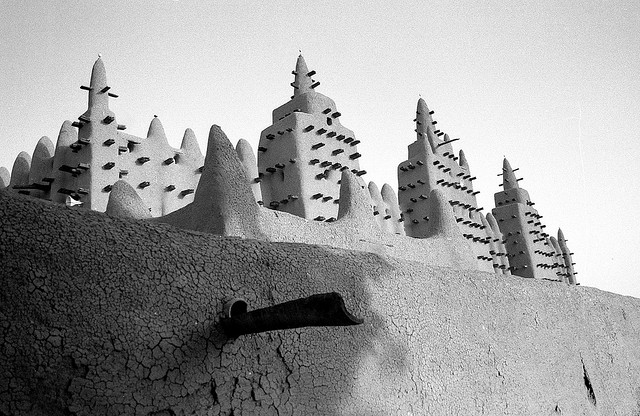This article on Djenne's main Mosque has been published in the Architect's Journal and shortlisted for the Writer's Awards. The original text can be found on Arub Saqib's blog

photos by Guillaume Colin & Pauline Penot on Flickr
Primitive. When most of us think 'African art', this is the word that springs to mind. African architecture is a subject detached further still from our understanding. An unrecognized art, architecture in Africa is usually observed through flickering documentaries and fading books categorized under anthropology or archaeology; studied in fleeting glimpses under subheadings of politics, colonialism and oil – interests that make mention of buildings only as a backdrop for more pressing concerns circling the continent.

photos by Mark Abel on Flickr
Yet the architecture of Africa is perhaps richer for the fact that it has remained dormant in our eyes, slipping away from our conscience like a half-remembered dream. Different in every sense of the word, from the materials to the form and construction, this indigenous and localised architecture remains untainted; singularly expressive of the dreams and desires of the society that produces it.
Islam is part of the established history of West Africa. Djenne (Mali), still a Muslim majority stronghold, is the oldest known city of sub-Saharan Africa. During the 13- 1400s, it was a thriving centre of mixed ethnic groups, bustling with cross-cultural commerce and scholarly learning rooted in the teachings of Islam. Although Timbuktu was the first Western 'port' in the Sahara, and is therefore better known in contemporary popular culture, it is Djenne, 400km upstream that was always teaming with life and activity. Its towering and majestic masajids (mosques) bare testament to this.
The Great Mosque of Djenne is built entirely out of mud. When the first French colonies saw it, they were bemused and perplexed by the temporal nature of such a building, unable to fathom why this important structure would be constructed out of so fragile a material. Used to judging the worth of a structure based on its permanence, the French were not impressed with walls that would ware away when their backs brushed against them. Yet what they failed to recognise was that these structures were constructed of the earth they were built on.
In any savannah environment mud is used almost exclusively as an indigenous building material, for small houses to large community centres. Primitive they may be from a singular point of view, but from another, an ingenious way of dealing with the environment and lifestyle of the people that live in these vast desert planes. The lack of patience afforded in understanding this difference is what has lead most Western critics to brand the architecture of sub-Saharan Africa as not architecture at all, but at most, building technology. Unable to look beyond the materials employed, these shelters have been seen only in terms of the techniques its builder commands, and not as conscious decisions that would inevitably lead to the aesthetic expression of the spirit of the people that live there.

photo by Martha de Jong-Lantink on Flickr
The Great Mosque itself is a monumental achievement, built on a massive scale, with pyramidal minarets that generate an extreme feeling of heaviness. Its minarets are built up solidly of mud; access to their roofs allows muazzins (the callers) to call the adhaan (call for prayer). The exterior surface of the mosque is pierced by projecting timber shafts that provide permanent scaffolding for the maintenance of the walls. The timber also transmits the stresses, which are set up when a mass of mud is subjected to rapid changes in humidity and temperature, concentrating the resultant cracking along prescribed lines.
A handmade building in the literal sense, there are no imported yellow American Cat dirt diggers, or stones made-in-China to be found here. The entire city, from small child to old man, owns this mosque, and is intrinsically bound to its maintenance and survival, as adobe buildings require periodic replenishing with mud to ensure violent seasons of rain don't melt the structures away. The re-plastering of the Great Mosque is a joyous event; an awesome, loud and fun festival that unites the congregation each Spring.
The night before the plastering, moonlit streets echo with chants, flutes and drums, stirring crowds from sleep into action. People bear baskets on their heads, waiting for a whistle to blow three times. On queue at the fourth blow, the entire throng sets off on a mud-fetch. By dawn, the re-plastering is underway. Young and old alike dump the mud on the mosque's terrace, caked with earth from head to toe, shouting and laughing. Against the facade of the mosque, men climb twelve-metre ladders wide enough for two to stand on a single rung, slapping and smoothing mud against ancient walls with their bare hands.
The Great Mosque of Djenne is the breathing, living heart that serves its community. This is the reason for the congregation resisting every attempt to change the character of their extraordinary building. First, it was the French in the 30s that attempted to paint the entire mosque red, but one season of heavy rain brought back the mosque's natural earthen colour. In the 80s, Saudi Arabia offered to re-build the mosque in concrete, and Libya wanted to tile its sand floor, but Djenne continued to decline. Its people have preserved their simplicity at the town's humble muddy centre; a building that serves them wonderfully, just the way it is.